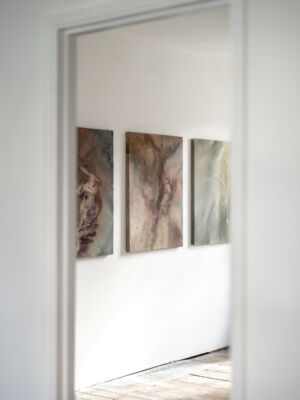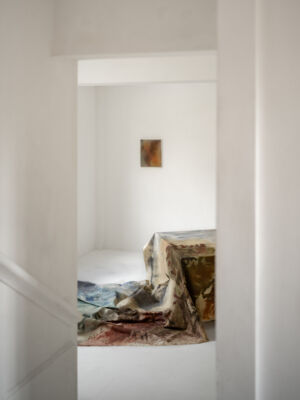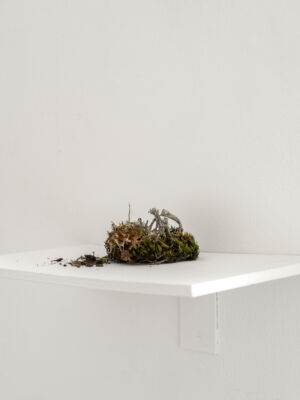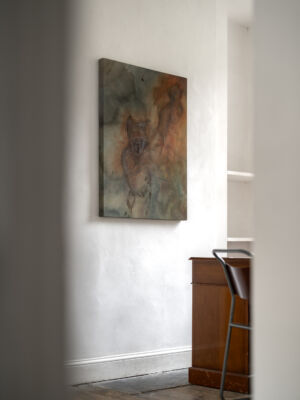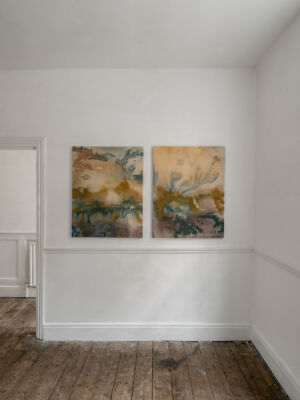Anna Blom
‘transference’
Curated by Jenn Ellis
September 26th- October 13th, 2024. Gallery 46, 46 Ashfield St, London, E1 2AJ
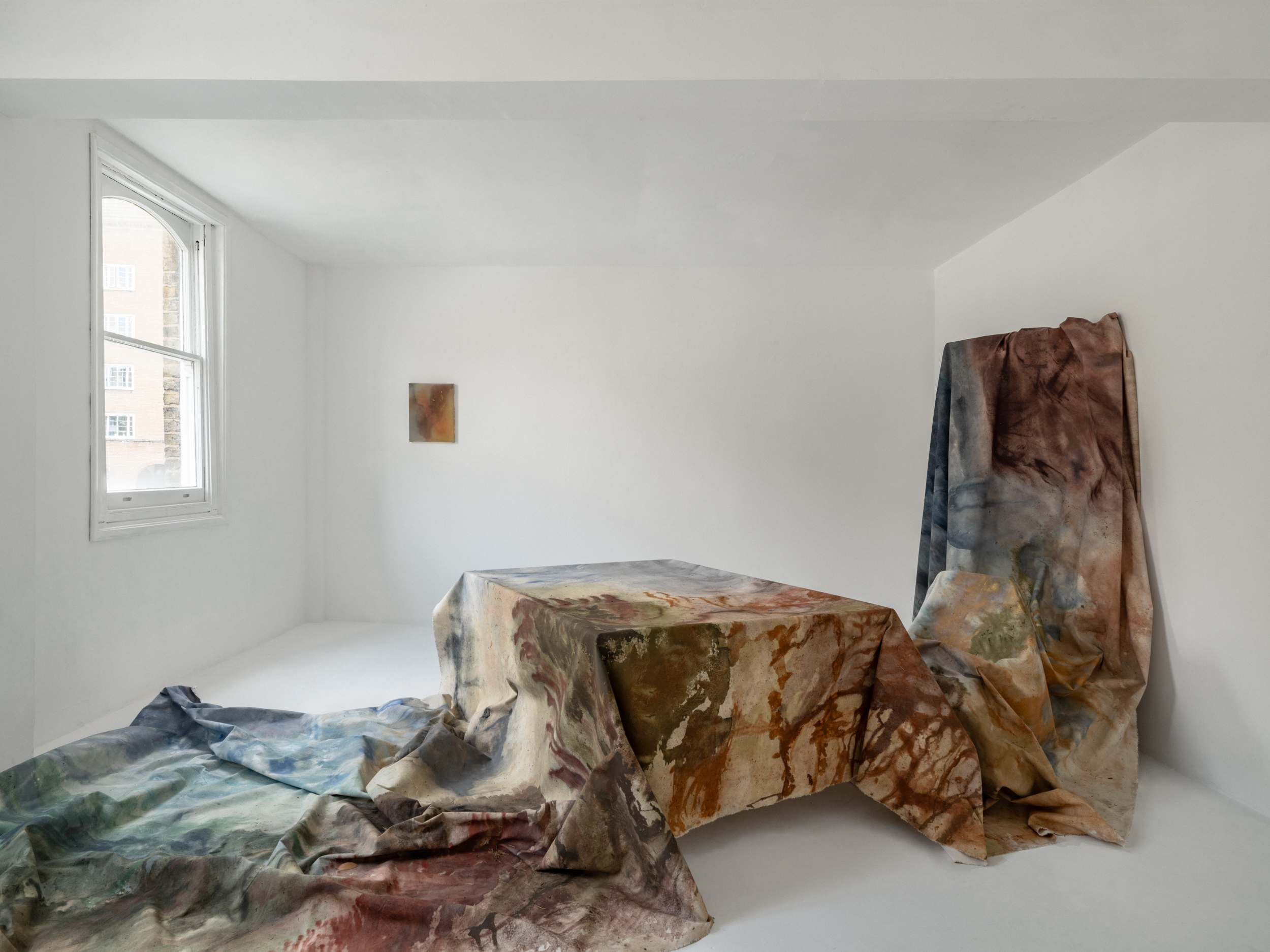
Anna Blom, ‘transference’, installation view Circadian Rhythms, 2024 and Between the noise, 2023. Photography by James Retief.
Exploring states of psychological transition, Anna Blom’s solo exhibition is conceived as an exploration of variance. Responding to contextual change and liminality, as well as the changes in oneself, the works are a series of articulations: poetic verbiage taking on a diaristic methodology. Accompanied by a programme: opening, dinner, roundtable discussion, the exhibition is conceived as a moment to engage with the work but also the space and each other.
Curated by London-based curator Jenn Ellis and founder of Apsara Studio, the solo exhibition will encompass new paintings created by Blom. Thinking carefully about art, space and context, the exhibition is conceived with harmonious dialogue in mind, reflecting spaces of interiority and exteriority.
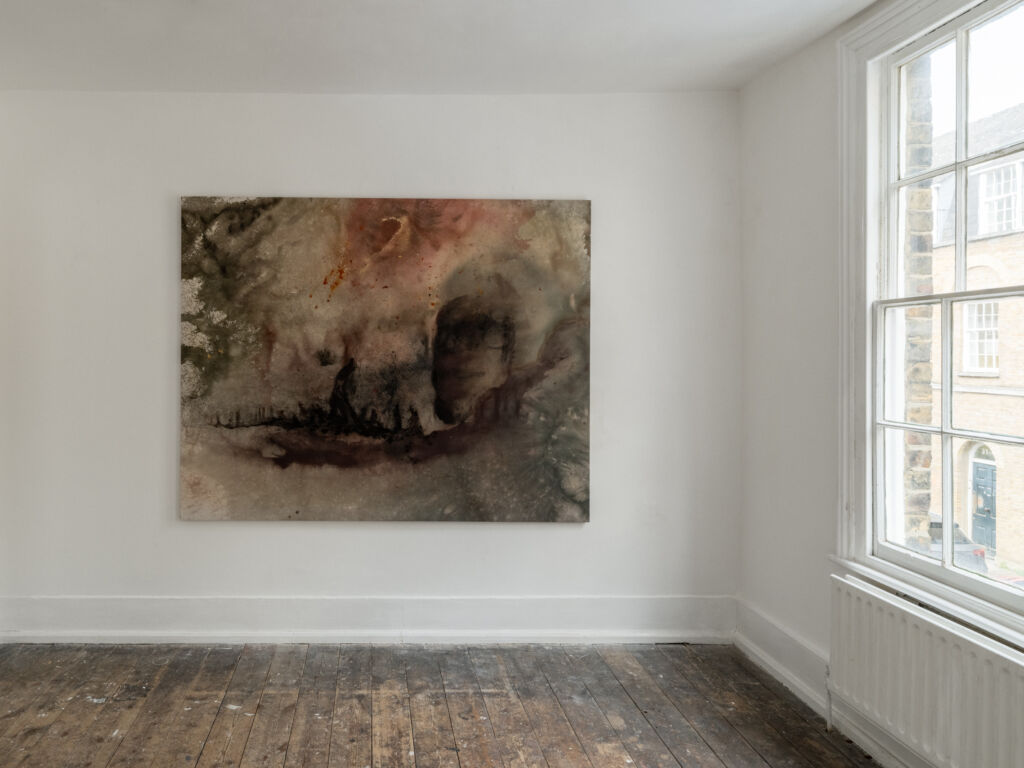
Anna Blom, ‘transference’, Jorm, 2024. Photography by James Retief.
Anna Blom’s practice is predicated on the diaristic, with each piece acting as a response to her environment and emotional state at any given moment. Her semi-abstract paintings, which she describes as “observational portraits”, contain traces of her continuous research; an archival process of investigating how individuals connect, combine and construct themselves through collecting objects, matter, white noise and writing. Drawing on this material, the artist deconstructs the fragile details of daily life in each piece, allowing transient forms to allude to the physical and psychological components of her lived experience.
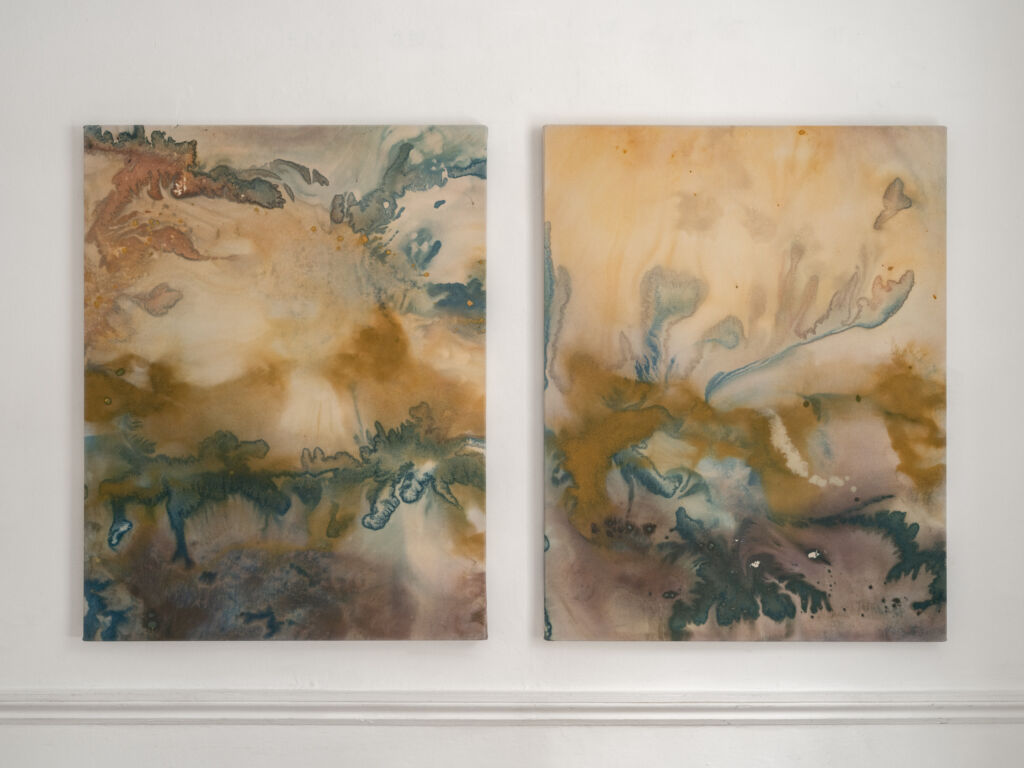
Anna Blom, ‘transference’, Neural Oscillations I and II, 2024. Photography by James Retief.
Her works also act as records of the environment in which they were created – Blom lays the unstretched canvas out in the open, exposed to the elements, and paints with raw pigment while allowing situational debris to fall upon the surface. The resultant textured, gritty and matt surfaces speak to the moment they were created, reflecting seasonality, weather conditions and the artist’s shifting emotional landscape.
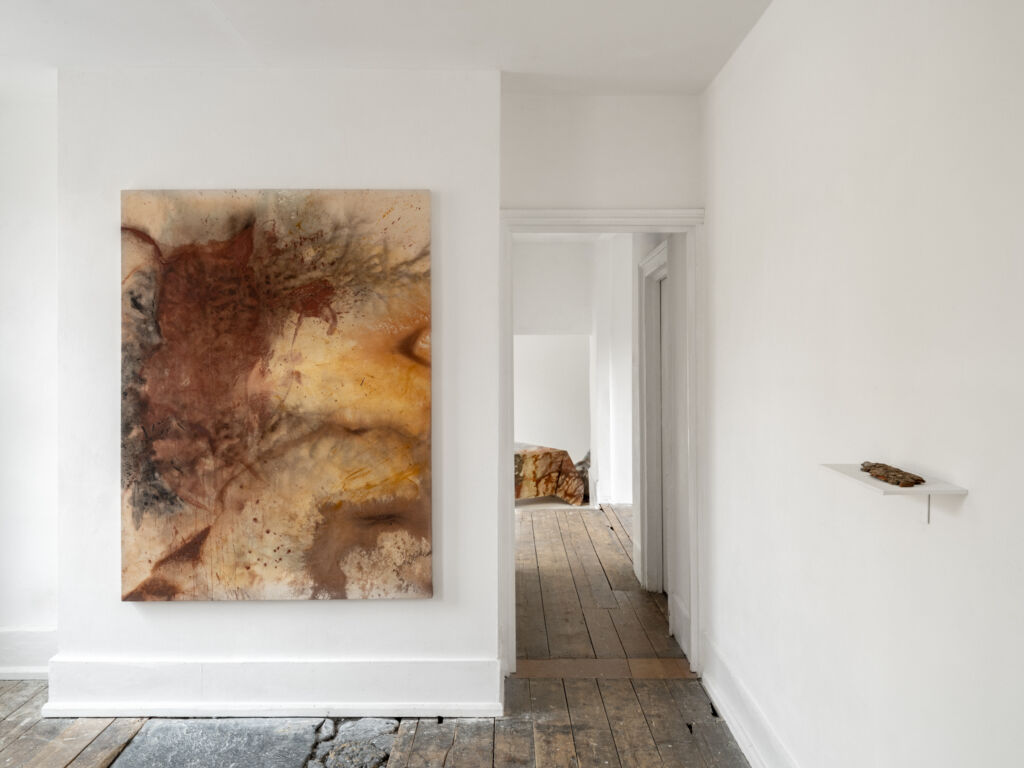
Anna Blom, ‘transference’, Beastly behaviour, 2024. Photography by James Retief.
Deliberately ephemeral, her paintings tell personal stories without the need for figuration. For Blom, they are fragments of a “painted philosophy”; a way of manifesting the complexity of human experience as an emotionally rich, transient and vulnerable state.
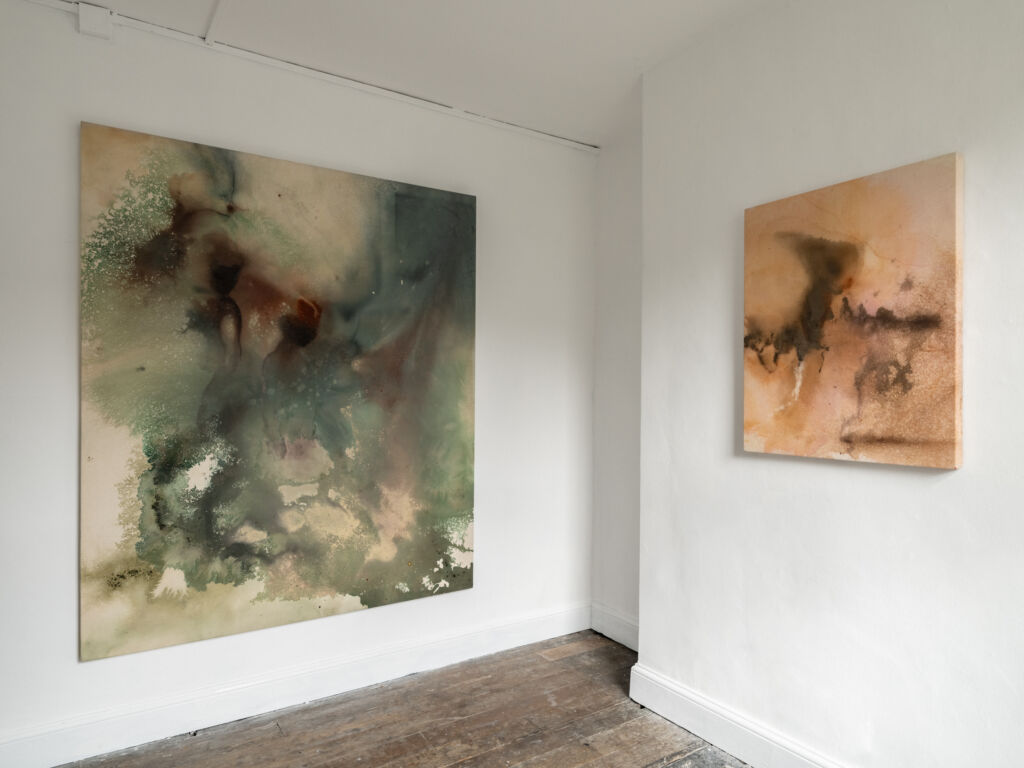
Anna Blom, ‘transference’. Left: The Unwelcome, 2024. Right: Ghost traveller, 2024. Photography by James Retief.
Anna Blom Interviewed by APSARA
‘My influences are many and varied; from historic artists, to contemporary philosophers, to the stories told by the 82 year old neighbour further down the street.’
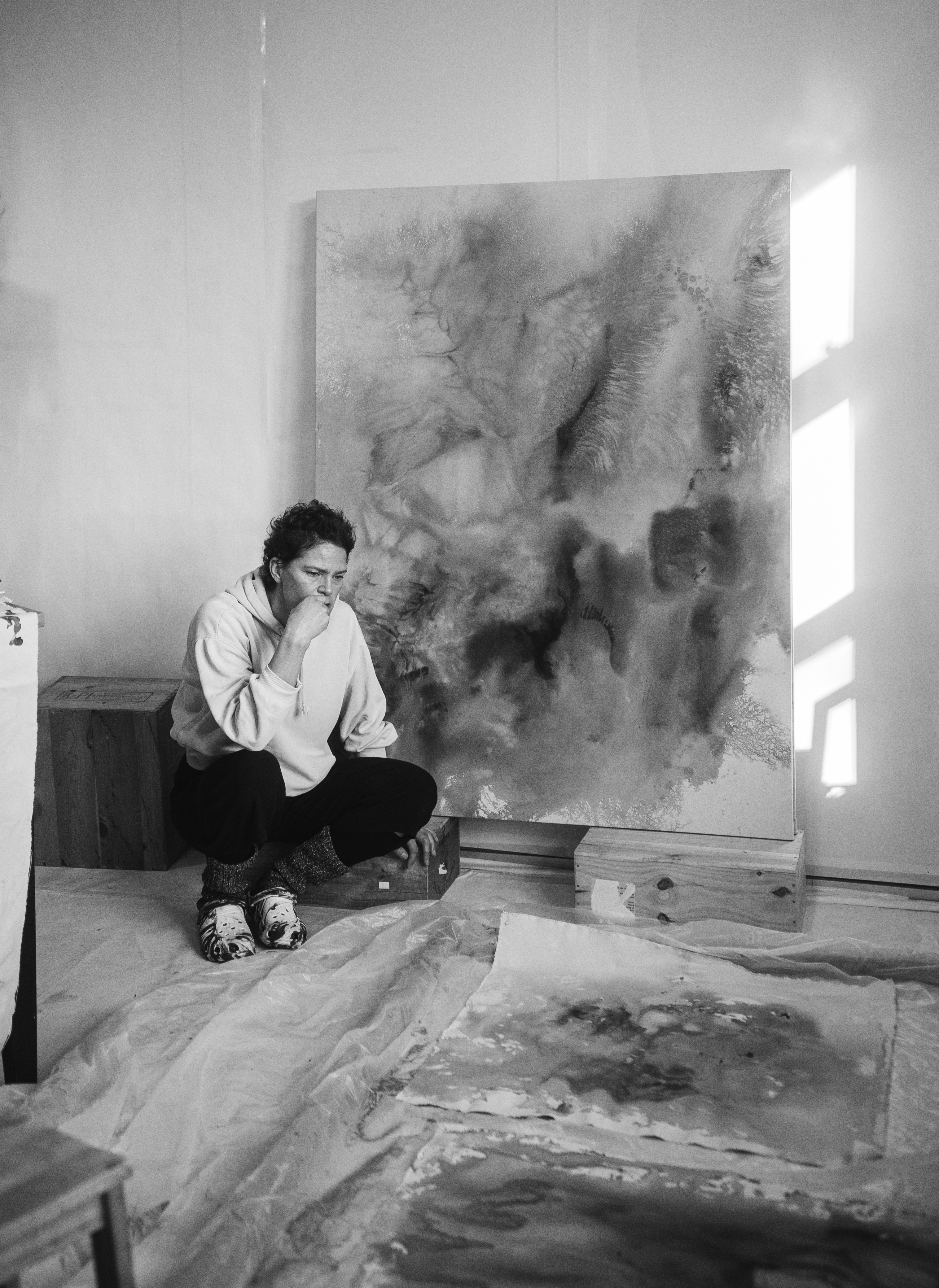
Anna, we are very excited about your solo exhibition. You mentioned that your work explores psychological transitions and variance. Could you explain how you approach translating these abstract concepts into the visual language of your paintings?
I’m excited too – thank you for having me!
My practice contemplates the diaristic, each piece acting as a response to my environment and emotional state at any given moment. I call the paintings ‘observational portraits’ and they contain my continuous research; an archival process of investigating how individuals connect, combine and construct themselves through collecting objects, matter, recording white noise and maintaining a writing chronicle. Drawing from these materials, I deconstruct the fragile details of daily life in each piece, allowing transient forms to allude to the physical and psychological components of my lived experience.
Curated by founder and curator of APSARA, Jenn Ellis, the exhibition is conceived as incorporating elements of both interiority and exteriority. How do you balance these themes in your work, and how do the spaces and contexts in which you create your paintings influence the final pieces?
The research table spills over with archived objects and debris from my surroundings. These physical elements are overlooked but constant in their presence. They help me build a perception of how we operate in this transient world of longing and unusual systems of existing. Their history and stories echo when they live in the painting as micro-downed pigment or debris, or near the painting on their own in close proximity. It is as if I’m grinding the essence of my surroundings.
Your approach to painting involves exposing the canvas to the elements of nature and using its raw pigments. How does this methodology imprint the form and content of your work?
The artworks act as records of the environment in which they were created, for example gravel from London streets, pine-tree needles from the forest floor of Sweden or microplastic by the Thames river bank. I lay the unstretched canvas out in the open, exposed to the elements, and paint with raw pigment while allowing situational debris to fall upon the surface. The resultant textured, gritty and matt surfaces speak to the moment they were created, reflecting seasonality, weather conditions, colours, light and the shifting emotional landscape.
We are struck by the notion of “painted philosophy” which is central to your work. How do you see your paintings contributing to or reflecting philosophical ideas about human vulnerability and the complexity of experience? Are there specific philosophical influences or ideas that also inform your personal experience?
I’m fascinated and confused by how we co-exist. My influences are many and varied; from historic artists, to contemporary philosophers, to the stories told by the 82 year old neighbour further down the street. Most of the time, I feel like a fly on the wall just watching, observing family, friends, encounters. Trying to translate what I feel: the love, the pain, the anger, the injustices, the reality of the world. To feel deeply opens up empathy. I share these personal stories, as a way of manifesting the complexity of human experience as an emotionally rich, transient and vulnerable state.
Finally Anna, in what ways do you see your work evolving in the future, and are there new themes or techniques you are interested in exploring? How do you envision these future directions influencing your practice?
It’s a constant looking, isn’t it? I’m interested in how the material and concepts talk to each other. For example, I spend the summers in my birthplace, Sweden, and I’m always struck by its light, colours and metal hues that permeates everything.
Sweden has one of the largest iron ore deposits in the world. I was born near a copper mine, I’m a granddaughter of a black smith and a daughter of steel worker. I’m from the land of iron. Painting in the forest, I try to see the multi-temporality and read the surroundings. While doing so, I’m leaning into the notion that we are all derivatives of the soil we stand on and the air we breathe. I like to think that the immediate circumstance of our physical existence allows us to participate more intently with, and un-isolated from our surroundings.
This recreates an interconnection, which makes me think nothing is completely isolated from each other. This weaving of stories with traces, scars and roots is to make an investigation in time and repair. I will further explore these ideas this winter with fellow Haematite explorers and opera singers Jess Dandy and Alex Mills – a collaboration I’m very excited about!
Thanks Anna!
Anna Blom is a Swedish born, London-based artist who holds an MA in Painting (Arts and Humanities) from the Royal College of Art (2022) and a BFA in Painting from UAL Wimbledon (2020). Her work has been featured in group exhibitions by galleries and curatorial projects including: Vortic, London (2024); Studio West, London (2024); Gertrude and Canopy Collections, London (2024); Flowers Gallery, London (2023); Hautes Côtes, Apsara Studio and Sothebys, Burgundy (2023); Liminal Gallery, Margate (2023); OHSH Projects, London (2023); Aora and Apsara Studio, London (2023); Ovada Gallery, Oxford (2023) and Orleans House Gallery, London (2022) among others.
